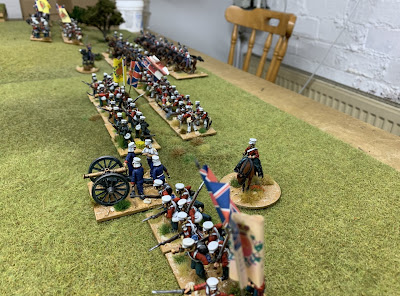I picked up these rules hoping for a good fit for my large Sikh Wars collections.
Mad Dogs and Englishmen are large scale skirmish rules so my instinct was they may not be the best fit for Divisional size Sikh Wars actions , however the author has played the rules with as many as 2,000 figures on table and has produced army lists and scenarios for the Sikh Wars so seemed worth a go.
The key thing missing were the chance cards, printed in the rule book, I don't have a photocopier to be able to print these off so unfortunately couldn't use them for this game. I feel these would add a lot to the game, next time hopefully.
Steve set up a game with 3 brigades of Sikh Foot and 2 Brigades of cavalry defending against 3 Brigades of Company troops and one Brigade of cavalry.Steve had read through the rules and had a reasonable idea of how they worked but we took our time over the game to be sure we had a reasonable grasp.
Each commander has a card and activation is on the turn of the commanders card so again you dont really get control of who goes when as you might in other rules. Again I like this.
Moving comes before firing, so we get going and 2 British brigade commanders come out first. Each has 4 command points so can order every unit they have. They advance and one gun is unlimbered and fires, one casualty caused. On my right the British are already in range so we unleash a long range volley which is surprisingly effective
Steves cavalry are next and he declines to use them yet, they have no where to go.
Steve is largely content to wait for the British to come to him. A wise choice given the low command ratings and historically accurate too. Probably for the same reason.
My cavalry are next, I decide to charge and take the extra D6 charge bonus, unfortunately I get the worst of all rolls, I am 25 inches from the Sikh foot and roll 23. This is going to be painful.
The rest of Steve's foot are out and content to wait for the British with a couple of counter volleys that do small ammounts of damage.
So far so good, a few things we cant find in the rules, can we interpenetrate? We assume we can and press on regardless.
Next go and the Sikhs facing the cavalry come out first. One volley and they completely wipe out the cavalry regiment to a man.
I take a quick photo before putting them back in the box.
Last card is Steves left hand brigade, Sikh foot and gun fire on my British battalion poor dice rolling leaves no casualties and 4 terror.
With the exception of the cavalry action this all seems very positive and the rules flow reasonably well with some nice mechanics.
Next move and my cavalry are out first, the remaining regiment charges the Sikh Foot. Closing fire requires a roll to determine range, Steve gets long range but still kills half of my cavalry, we then fail a morale and flee. However as we want to see how melee works we assume they passed and go through the phase. As the foot get a dice per figure for both ranks and with bonuses for being Sikh fight as well as the horse, the horse are wiped out to a man inflicting no casualties on the Sikhs.
My right hand brigade are next, my commander using 2 command poitns to remove all of the terror on the British and we charge the Sikh foot, a quick melee sees 14 out of the Sikh 20 killed, again very, very bloody, the Sikhs fail their morale test and retreat behind their next unit.
On my left the British advance to point blank range and volley the first unit of tribesmen who not unnaturally run away. The three sepoy units advance cautiously and unleash two ineffective volleys at the other units of tribesmen.
In the cnetre the gun and two Sikh battalions make a proper mess of my British unit with far more terror than figures I take a morale test but pass.
On the left the tribesmen fire a volley into a Sepoy unit, a good roll sees 9 kills and whilst the sepoys pass their morale they are in proper trouble. Again this feel a little too bloody.
At this point we run out of time with everything still to play for, only three moves but that's ok we took our time to get a feel for the rules and checked things as we went along.




































































